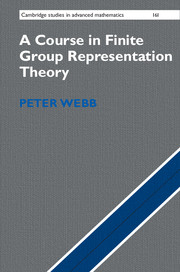Book contents
- Frontmatter
- Contents
- Preface
- 1 Representations, Maschke's Theorem, and Semisimplicity
- 2 The Structure of Algebras for Which Every Module Is Semisimple 15
- 3 Characters
- 4 The Construction of Modules and Characters
- 5 More on Induction and Restriction: Theorems of Mackey and Clifford
- 6 Representations of p-Groups in Characteristic p and the Radical
- 7 Projective Modules for Finite-Dimensional Algebras
- 8 Projective Modules for Group Algebras
- 9 Changing the Ground Ring: Splitting Fields and the Decomposition Map
- 10 Brauer Characters
- 11 Indecomposable Modules
- 12 Blocks
- Appendix A Discrete Valuation Rings
- Appendix B Character Tables
- Bibliography
- Index
10 - Brauer Characters
Published online by Cambridge University Press: 05 August 2016
- Frontmatter
- Contents
- Preface
- 1 Representations, Maschke's Theorem, and Semisimplicity
- 2 The Structure of Algebras for Which Every Module Is Semisimple 15
- 3 Characters
- 4 The Construction of Modules and Characters
- 5 More on Induction and Restriction: Theorems of Mackey and Clifford
- 6 Representations of p-Groups in Characteristic p and the Radical
- 7 Projective Modules for Finite-Dimensional Algebras
- 8 Projective Modules for Group Algebras
- 9 Changing the Ground Ring: Splitting Fields and the Decomposition Map
- 10 Brauer Characters
- 11 Indecomposable Modules
- 12 Blocks
- Appendix A Discrete Valuation Rings
- Appendix B Character Tables
- Bibliography
- Index
Summary
After the success of ordinary character theory in computing with representations over fields of characteristic zero we wish for a corresponding theory of characters of representations in positive characteristic. Brauer characters provide such a theory and we describe it in this chapter, starting with the definition and continuing with their main properties, which are similar in many respects to those of ordinary characters. We arrange the Brauer characters in tables that satisfy orthogonality relations, although of a more complicated kind than what we saw with ordinary characters. We will find that the information carried by Brauer characters is exactly that of the composition factors of a representation, and not more. They are very effective if that is the information we require, but they do not tell us anything more about the range of complicated possibilities that we find with representations in positive characteristic. Using Brauer characters is, however, usually the bestway to compute a decompositionmatrix, and hence a Cartan matrix in view of Corollary 9.5.6.We obtain in Corollary 10.2.4 the deductions that the Cartanmatrix is invertible and the decompositionmatrix has maximum rank.
The Definition of Brauer Characters
Whenever we work with Brauer characters for a finite group G in characteristic p we will implicitly assume that we have a p-modular system (F, R, k) where both F and k are splitting fields for G and all of its subgroups. This has the implication that F and k both contain a primitive ath root of unity, where a is the l.c.m. of the orders of the p-regular elements of G (the elements of order prime to p). If we wish to define the Brauer character of a kG-moduleU where k or F do not contain a primitive ath root of unity, we first extend the scalars so that the p-modular system does have this property.
We now examine the relationship between the roots of unity in F and in k. Let us put
Lemma 10.1.1. With this notation,
(1) μF ⊆ R, and
(2) the quotient homomorphism R → R/(π) = k gives an isomorphism μF → μk.
Information
- Type
- Chapter
- Information
- A Course in Finite Group Representation Theory , pp. 192 - 212Publisher: Cambridge University PressPrint publication year: 2016
